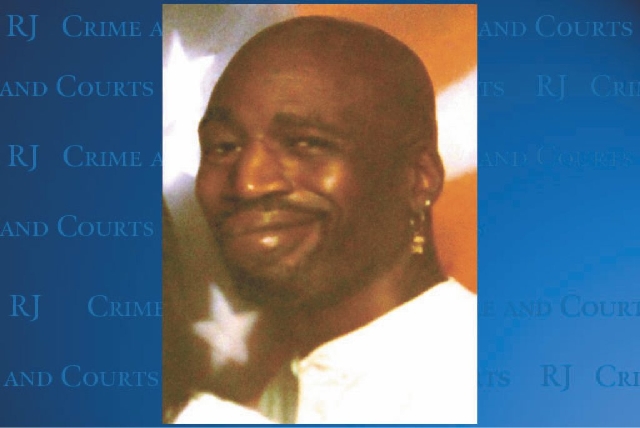Criminal charges won’t be filed in police shooting of veteran

Stanley Gibson didn’t have a gun and he posed no threat.
But that doesn’t matter in the eyes of the law.
“The Nevada Supreme Court makes it perfectly clear that the mere perception of danger, as opposed to actual danger, is sufficient to warrant a killing in self-defense,” Clark County prosecutors wrote in their final report on the police shooting of the mentally ill Gulf War veteran.
District Attorney Steve Wolfson said Thursday that the Las Vegas police officers involved in Gibson’s death would not face criminal charges, a decision that was expected but had been looming since his death on Dec. 12, 2011.
Gibson, 43, was shot and killed when officer Jesus Arevalo fired seven shots from his AR-15 rifle into Gibson’s Cadillac during a standoff that began with a mistaken report of an attempted burglary at the Alondra apartments at 2451 N. Rainbow Blvd., near Smoke Ranch Road.
Gibson, who recently had moved, had driven to the wrong apartment complex as he tried to find his way home.
His death, in addition to a Las Vegas Review-Journal series analyzing police shootings, prompted a federal investigation of the Metropolitan Police Department and sweeping changes in its use-of-force policies.
“Mr. Gibson’s death was especially tragic because there were so many missed opportunities to get him the help he so obviously needed,” Wolfson said in a statement. “I believe that if the officers were presented with these same circumstances today, we would have a different outcome.”
The shooting was heavily scrutinized by the public, and Wolfson gave the case an even longer look.
In a rare move, the district attorney’s office presented the case to a Clark County grand jury, which in December declined to indict anyone in connection with the death.
Wolfson noted that police made several mistakes before the shooting, including a critical “breakdown in communication,” between supervisors and officers.
Sgt. Michael Hnatuick’s initial plan called for officers to approach Gibson’s car, which had been blocked in by two patrol cars and was disabled, from the left rear.
At the time, it was not known whether Gibson had a weapon, and the approach would give officers an element of surprise in their attempt to pull him from the car.
Officer Malik Grego-Smith was to shoot out the Cadillac’s rear window with a beanbag shotgun, and Hnatuick was to blast pepper spray into the car.
Arevalo was to provide cover with his AR-15 on the left side of Gibson’s car.
But before the plan was executed, Lt. David Dockendorf arrived on scene, took control of the operation and pulled the officers back.
Arevalo, assuming the plan had been called off, asked to provide cover on the right side of the command post, separated from his supervisors by a concrete trash bin enclosure.
Hnatuick agreed.
A short time later, Gibson, who had been lying down in his car, sat up and began revving the engine and spinning the wheels.
Gibson had done this several times, but Dockendorf hadn’t been there to see it.
Dockendorf reacted by grabbing Grego-Smith’s shoulder and yelling into his radio, “All right, units, we’re moving in. Shoot.”
Dockendorf meant only that Grego-Smith was to shoot the bean bag gun, but his command was broadcast to all because his microphone was still open. Many officers told detectives that their radios were not working properly and they never heard Dockendorf’s order.
“This was a catastrophic error, which likely resulted from Lieutenant Dockendorf’s concern upon seeing, for the first time, (Gibson’s) efforts to free his vehicle,” prosecutors wrote.
A split-second after Grego-Smith shot out the Cadillac’s rear passenger window, Arevalo fired his rifle, hitting Gibson four times.
Dockendorf had substantially changed Hnatuick’s plan by approaching from a different angle and shooting the rear passenger-side window instead of the rear window.
“Because of the unusually dark tint of the windows of the vehicle, he (Arevalo) could have reasonably believed there was a gunshot being fired from (Gibson’s) vehicle rather than into the vehicle,” prosecutors wrote.
“If this were the case, Officer Arevalo had the right to discharge his weapon at the Cadillac in self-defense or in the defense of others.”
Rudy Gibson, Stanley Gibson’s brother, said he was confused about Wolfson’s decision, although not surprised.
Rudy Gibson still is angry — and not just at Arevalo, but also at Dockendorf’s error.
“I’m pretty sure that if he hadn’t shown up, my brother wouldn’t be dead right now,” he said. “I don’t understand the law, I guess. If these guys screw up that badly, how could that not be criminal?”
Wolfson’s report also noted the failed attempts to help Stanley Gibson, who was having hallucinations and was off his anxiety medication.
In the 48 hours before his death, Gibson had three interactions with police officers and three separate interactions with paramedics. Each time, Gibson demonstrated severe anxiety and paranoia. But he was never treated.
In one incident, he tried to punch a Las Vegas police officer and was arrested. Although the officer asked that Gibson receive a psych evaluation from the jail’s medical staff, he was released a few hours later because of crowding.
After Gibson’s release from jail and 26 hours before his death, he walked alone to the Golden Nugget.
He grabbed a handful of chips and threw them across a roulette table, then scooped $100 in chips from a blackjack table and asked to be dealt cards.
“I just had to try it once to see what it was like,” he told officers, who cited him for petty theft. “I’ve lived in this town my whole life and seen these casinos being built, and people throwing money on the tables, and I didn’t get the reaction I was expecting.
“I thought people would stand and cheer.”
Contact reporter Mike Blasky at mblasky@reviewjournal.com or 702-383-0283.